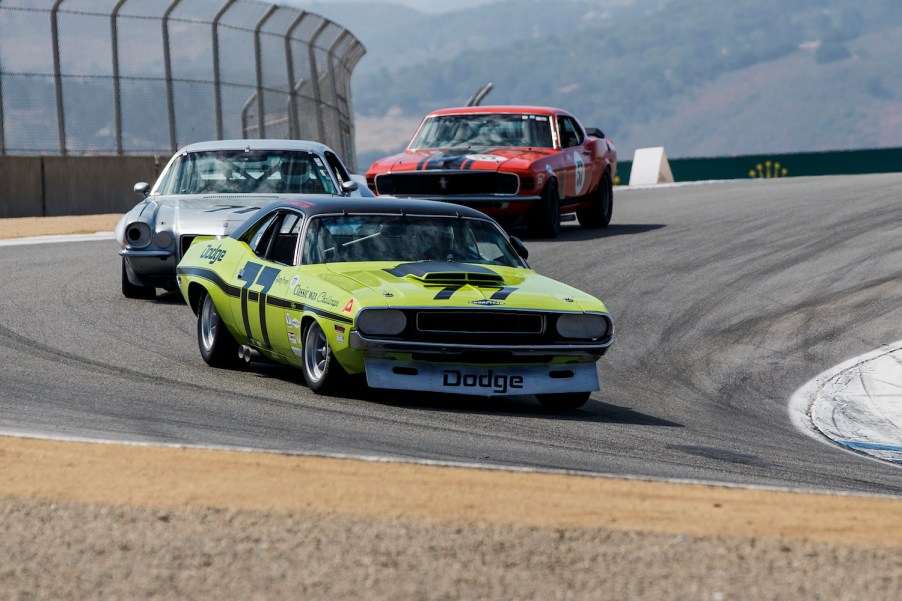
Dodge’s ‘Fast Follower’ Strategy Made the 1970 Challenger One of the Best Pony Cars of All Time–Will It Work for EVs?
In the business world, a “fast follower” is a company that leaves pioneering new technologies and market segments to its competitors. When something proves profitable, this company will then pay for whatever intellectual property–or employees–it needs to be competitive. It might not be the most exciting strategy, but it gave us classic cars such as the 1970 Dodge Challenger–easily one of the best pony cars ever built. Will Dodge be able to re-apply this strategy to the electrification and automation revolutions?
Dodge floundered in the pony car race, at first

When Ford launched the original Mustang, American drivers couldn’t get enough of the stylish and cheap coupe. Ford actually had to build over 500,000 classic Mustangs to meet demand in 1965 alone. General Motors scrambled to develop a competitor and launched the Camaro in September 1966. The pony car races were off to a gallop.
What did Dodge do? It waited. In Dodge’s defense, its Plymouth cousin had introduced the fastback Barracuda as a package for the Valiant a few months before the Mustang. Chrysler Corporation (also called Mopar) brass asked Dodge not to compete with Plymouth directly, so the brand went to war in the large coupe market with its 1966 Charger.
The Charger didn’t do nearly as well as the Mustang, and the Plymouth Barracuda went through a couple of generations that only appealed to Mopar enthusiasts. So Dodge and Plymouth got together to design a new pony car chassis.
The 1970 Dodge Challenger nailed the mark

The designers of the Dodge/Plymouth joint project knew drivers were spending increasingly more money on high-performance V8 versions of both the Mustang and Camaro. So they borrowed the chassis of the Charger, which was engineered to fit around Mopar’s big-block V8s.
The Mopar designers shortened the car’s wheelbase to a pony-car-appropriate 110 inches (108 for the Barracuda). Then they chopped down the new car’s rear deck, lengthened its hood, and created slab-sided body panels for a muscular look. The result was the all-new 1970 Dodge Charger and third-generation Plymouth Barracuda.
This “E-body” chassis not only looked fast, but it was large enough to handle Mopar’s V8 engines. Options included the NASCAR-homologation 426 HEMI V8 and a more nimble 340 cubic-inch V8 in the Trans-America version. While the first-generation Dodge Challenger was not the most popular car of its era, and was only available until 1974, it became a cult classic. Today, it is widely regarded as one of the best vehicles of the muscle car era.
Can Dodge be a ‘fast follower’ again?

The automobile industry is changing just as fast as it did during the pony car days. Twin revolutions–electrification and automation–promise to transform the way we travel, forever.
General Motors jumped into the EV space with its popular Volt plug-in hybrid back in 2011. By 2019, Ford debuted its all-electric Mustang Mach-E. An electric version of the F-150, the Lightning, launched in April 2022. General Motors and Ford are also building dueling driver-aid systems.
What is Dodge’s Stellantis parent company doing? Waiting, watching, and learning. This year, we finally got an electric concept from Dodge: the Charger Daytona SRT “Banshee.” The brand is also promising an electric lineup by 2024.
Dodge used this time to take inventory of the electric vehicle segment. For example, even Teslas’ charging speeds are held back by a 400-volt electrical system. Dodge pioneered one of the first 800-volt systems and promises to leap to the head of the segment. The automaker is also trying out new solutions such as a front wing instead of a front trunk, and an eRupt manual transmission.
So will Dodge’s fast-follower strategy lead to one of the more compelling production vehicles in its segment? We’ll just have to wait for 2024 to find out. Next, find out why the new electric Charger should be named the Dodge 880 or learn more about the future of gasoline-powered Dodges in the video below:



